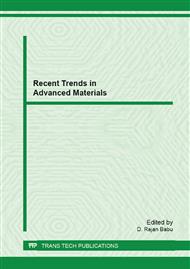[1]
E.H. Kim, H.S. Lee, B.K. Kwak, B.K. Kim, Synthesis of ferrofluid with magnetic nanoparticles by sonochemical method for MRI contrast agent, J. Magn. Magn. Mater., 289 (2005) 328-330.
DOI: 10.1016/j.jmmm.2004.11.093
Google Scholar
[2]
S. Dubus, J.F. Gravel, B.L. Drogoff, P. Nobert, T. Veres, D. Boudreau, PCR-Free DNA Detection Using a Magnetic Bead-Supported Polymeric Transducer and Microelectromagnetic Traps, Anal. Chem.78 (2006) 4457-4464.
DOI: 10.1021/ac060486n
Google Scholar
[3]
Y.C. Chang, D.H. Chen, Preparation and adsorption properties of monodisperse chitosan-bound Fe3O4 magnetic nanoparticles for removal of Cu(II) ions, J. Colloid Interface Sci., 283 (2005) 446-451.
DOI: 10.1016/j.jcis.2004.09.010
Google Scholar
[4]
C.Q. Hu, Z.H. Gao, X.R. Yang, Fabrication and magnetic properties of Fe3O4 octahedra, Chem. Phys. Lett., 429 (2006) 513-517.
DOI: 10.1016/j.cplett.2006.08.041
Google Scholar
[5]
F.Q. Hu, Z. Li, C.F. Tu, M.Y. Gao, Preparation of magnetite nanocrystals with surface reactive moieties by one-pot reaction, J. Colloid Interface Sci., 311 (2007) 469-474.
DOI: 10.1016/j.jcis.2007.03.023
Google Scholar
[6]
R.Y. Hong, T.T. Pan, H.Z. Li, Microwave synthesis of magnetic Fe3O4 nanoparticles used as a precursor of nanocomposites and ferrofluids, J. Magn. Magn. Mater., 303 (2006) 60-68.
DOI: 10.1016/j.jmmm.2005.10.230
Google Scholar
[7]
R. Suresh, R. Prabu, A. Vijayaraj, K. Giribabu, A. Stephen, V. Narayanan, Fabrication of α-Fe2O3 nanoparticles for the electrochemical detection of uric acid, Synth. React. Inorg. Metal-Org. nano-Met. Chem., 42 (2012), 303–307.
DOI: 10.1080/15533174.2011.610022
Google Scholar
[8]
R. Boistelle, J.P. Astier, Crystallization mechanisms in solution, J. Cryst Growth, 90 (1988) 14-30.
Google Scholar
[9]
X. Chen, Y. Wang, J. Zhou, W. Yan, X. Li, J.J. Hu, Electrochemical Impedance Immunosensor Based on Three-Dimensionally Ordered Macroporous Gold Film, Anal. Chem., 80 (2008) 2133-2140.
DOI: 10.1021/ac7021376
Google Scholar
[10]
A. Kaushik, R. Khan, P.R. Solanki, P. Pandey, J. Alam, S. Ahmad, B.D. Malhotra, Iron oxide nanoparticles–chitosan composite based glucose biosensor, Biosens. Bioelectron., 24 (2008) 676-683.
DOI: 10.1016/j.bios.2008.06.032
Google Scholar
[11]
S. Reddy, B.E. Kumara Swamy, U.B. Chandra, S. Sherigara, H. Jayadevappa, Synthesis of CdO nanoparticles and their modified carbon park electrodes for determination of dopamine and ascorbic acid by using cyclic voltammetry technique, Int. J. Electrochem. Sci., 5 (2010)10-17
DOI: 10.1016/s1452-3981(23)15262-x
Google Scholar


